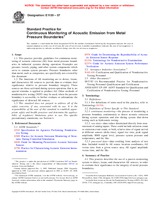Potrebujeme váš súhlas na využitie jednotlivých dát, aby sa vám okrem iného mohli ukazovať informácie týkajúce sa vašich záujmov. Súhlas udelíte kliknutím na tlačidlo „OK“.
ASTM E1139-07
Standard Practice for Continuous Monitoring of Acoustic Emission from Metal Pressure Boundaries
Automaticky preložený názov:
Štandardná prax pre kontinuálne sledovanie akustické emisie z kovových tlakových hraníc
NORMA vydaná dňa 1.12.2007
Informácie o norme:
Označenie normy: ASTM E1139-07
Poznámka: NEPLATNÁ
Dátum vydania normy: 1.12.2007
Kód tovaru: NS-40593
Počet strán: 6
Približná hmotnosť: 18 g (0.04 libier)
Krajina: Americká technická norma
Kategória: Technické normy ASTM
Anotácia textu normy ASTM E1139-07 :
Keywords:
acoustic emission, acoustic emission source location, continuous monitoring, leak detection, metal piping, metal pressure vessels, pressure systems, Acoustic emission (AE) testing--metals/metallic materials, Automated procedures--metals/alloys, Continuous measurement/monitoring, Data analysis--metals/alloys, Electrical measurements, Industrial metals/alloys, Integrity testing, Leak testing, Metal pressure boundaries, Metals and metallic materials, Monitoring, Piping systems
Doplňujúce informácie
| Significance and Use | ||||||||||||||||||
| p>Acoustic emission examination of a structure requires
application of a mechanical or thermal stimulus. In this case, the
system operating conditions provide the stimulation. During
operation of the pressurized system, AE from active discontinuities
such as cracks or from other acoustic sources such as leakage of
high-pressure, high-temperature fluids can be detected by an
instrumentation system using sensors mounted on the structure. The
sensors are acoustically coupled to the surface of the structure by
means of a couplant material or pressure on the interface between
the sensing device and the structure. This facilitates the
transmission of acoustic energy to the sensor. When the sensors are
excited by acoustic emission energy, they transform the mechanical
excitations into electrical signals. The signals from a detected AE
source are electronically conditioned and processed to produce
information relative to source location and other parameters needed
for AE source characterization and evaluation.
AE monitoring on a continuous basis is a currently available method for continuous surveillance of a structure to assess its continued integrity. The use of AE monitoring in this context is to identify the existence and location of AE sources. Also, information is provided to facilitate estimating the significance of the detected AE source relative to continued pressure system operation. Source location accuracy is influenced by factors that affect elastic wave propagation, by sensor coupling, and by signal processor settings. It is possible to measure AE and identify AE source locations of indications that cannot be detected by other NDT methods, due to factors related to methodological, material, or structural characteristics. In addition to immediate evaluation of the AE sources, a permanent record of the total data collected (AE plus pressure system parameters measured) provides an archival record which can be re-evaluated. |
||||||||||||||||||
| 1. Scope | ||||||||||||||||||
|
1.1 This practice provides guidelines for continuous monitoring of acoustic emission (AE) from metal pressure boundaries in industrial systems during operation. Examples are pressure vessels, piping, and other system components which serve to contain system pressure. Pressure boundaries other than metal, such as composites, are specifically not covered by this document. 1.2 The functions of AE monitoring are to detect, locate, and characterize AE sources to provide data to evaluate their significance relative to pressure boundary integrity. These sources are those activated during system operation, that is, no special stimulus is applied to produce AE. Other methods of nondestructive testing (NDT) may be used, when the pressure boundary is accessible, to further evaluate or substantiate the significance of detected AE sources. 1.3 This standard does not purport to address all of the safety concerns, if any, associated with its use. It is the responsibility of the user of this standard to establish appropriate safety and health practices and determine the applicability of regulatory limitations prior to use. For specific precautionary statements, see Section 6. |
||||||||||||||||||
| 2. Referenced Documents | ||||||||||||||||||
|
Odporúčame:
Aktualizácia technických noriem
Chcete mať istotu, že používate len platné technické normy?
Ponúkame Vám riešenie, ktoré Vám zaistí mesačný prehľad o aktuálnosti noriem, ktoré používate.
Chcete vedieť viac informácií ? Pozrite sa na túto stránku.




 Cookies
Cookies
